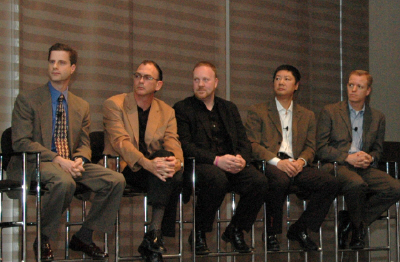Office 2.0 meets the enterprise

The morning discussions at the Office 2.0 conference centered on bringing 2.0 (Web, Office, Enterprise, Lunch, Dinner, and my favorite, Work, etc.) into the mainstream of business usage. CIOs and IT departments were singled out as gatekeepers who try to keep Web cloud applications from getting on their networks--lack of security, auditing and integration with corporate systems as major barriers to entry. Nonetheless, instant messaging, Web mail, wikis and other technology are seeping into organizations whether they like it or not.
Almost all who participated in the discussion agree that a hybrid approach, which Microsoft espouses, that ideally seamlessly combines online and offline will be dominant over the next few years. "It's not a polar issue," said Don Campbell, Microsoft Office evangelist. "Web 2.0 to us is more of hybrid model, the best of the client and services world." The evidence to support his claim is that you cannot count on uninterrupted broadband bandwidth to maintain connectivity 24x7 on the ground or in the air. Poor bandwidth was a problem for some of the demos at the conference.

Making Office 2.0 Enterprise Ready panelists: Ken Rudin (LucidEra), Craig Remy (Intacct), Matthew Quinn (Tibco), Ivan Koon (YouSendIt), John Roberts (SugarCRM)
Ken Rudin, CEO of LucidEra, stated that 2.0 applications don't become success by replicating the past or automating the past to do the wrong things faster. "Real success comes with innovation, not just blind copying," he said.
The definition of Office 2.0 was also an ongoing topic of discussion. Lew Tucker, formerly of Sun, Salesforce.com and now at Radar Networks, described Office 2.0 as "less of a cateogry of application than an approach and strategy businesses are taking to meet application needs."
The approach is built around online applications with collaboration at the core. It is evolutionary rather than revolutionary. According to Bob Sutor, IBM, all of the pieces are already out there, and it's not a deep computer science problem. The challenge is to make it lightweight enough while providing what users need in to do their work.
Most of the new crop of applications are not breaking any new user interface ground, other than using AJAX to make it more like a desktop client. Integrating mashups into the user experience is where the most interesting work is happening.
Of course, companies will differ in how they adopt 2.0 technologies. IBM has thousands of internal bloggers, but also is standardized on its Lotus Notes for email and collaboration. Any small company or startup, however, isn't going to think about getting a Microsoft Exchange or Lotus Notes server--they will get a Web-based, open sourced solution or uses Google's services.
Sutor, speaking for IBM with over 300,000 employees, said, "Once you get to a certain size, you want to have the services hosted inside the firewall." It will take many turns of the crank for larger companies to trust any vital data living outside their firewalls. When you put money in a bank, there is the possibility of the bank getting robbed. You might lose some money (hopefully it's federally insured). When you put sensitive data in the cloud, you have the potential to lose your company if the servers are breached.
See also: Alan Graham posts a list of eight things that Office 2.0 needs, such as sychronization, access to personal storage devices, speed and reliability.